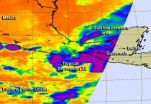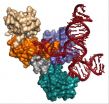Prototype electrolyte sensor to provide immediate read-outs
Painless wearable microneedle device may reduce trips to doctors' offices
2014-06-03
(Press-News.org) ALBUQUERQUE, N.M. — Patients trying to navigate today's complex medical system with its costly laboratory analyses might prefer a pain-free home diagnostic device, worn on the wrist, that can analyze, continuously record and immediately remedy low electrolyte levels.
Runners, athletes in other strenuous sports and soldiers on long missions also might prefer immediate knowledge of their electrolytic states as an aid to improved performance. Electrolytes such as potassium, calcium, magnesium and other salts are key in carrying nerve impulses that tell the heart and other muscles when to contract or relax.
In response to this need, Sandia National Laboratories researcher Ronen Polsky and colleagues are patenting a prototype model that can analyze various electrolyte levels on the spot, yet fit in a palm or be worn on a wrist. The device, when commercially available, could decrease the time ordinary citizens, athletes and the military must spend in emergency rooms, lab testing facilities or doctors' offices.
"This is the future of personalized health care," said Polsky. "These wearable technologies are just starting to come out in different forms. It's inevitable that people will go there."
The device is painless because it employs microneedles so tiny they don't traumatize nerves when pressed into the skin. It also samples only interstitial fluid — the liquid between skin cells. Thus the device has the potential for long-term, noninvasive use.
"We're proposing a minimally invasive way to move away from centralized laboratory testing," said Polsky.
In a paper published as a cover feature in the June issue of Advanced Healthcare Materials, Polsky, Sandia colleagues and University of North Carolina and North Carolina State University graduate student Phil Miller describe using a laser to create strong hollow microneedles that suck nearly infinitesimal amounts of colorless fluid from just beneath the skin's surface. The paper demonstrates that tiny amounts of potassium passed unhindered through the microneedle pores into a fluidic cartridge containing carbon electrodes. These measured the amount of this key electrolyte without being confused by the presence of other electrolytes in the fluid.
Miller said it's easy to change the selectivity of the carbon electrodes to detect and measure other such electrolytes like sodium or calcium in the same device. "We want to make the device wearable, noninvasive, and with real-time readout to constantly measure things a doctor might normally order for laboratory tests," he said.
Eventually the researchers envision a "sense-respond" device where some needles can read electrolytes while other needles, on demand, send electrolytes to make up for deficiencies.
Said Polsky, "Investors have expressed interest in commercial applications for the technology in healthcare and sports medicine, among other areas."
University of New Mexico (UNM) physician and researcher Justin Baca, who will lead human testing of the device, added, "Development of this benchtop device into a handheld model for consumers and patients will be a true partnership between a clinician and an engineer."
Sometimes sensor technologies work well, but problems arise when they are adapted to living systems, Baca said. "We're trying to get at this problem from the beginning to develop the best needle geometry."
Baca, with a background in physical chemistry and a practice in emergency medicine, said he has initial approval from UNM's Human Research Protection Office review board to start tests. He's interested, he said, because "it's hard, using traditional methods, to take blood samples continuously." Interstitial fluids should be far easier to sample, Baca said.
INFORMATION:
The initial sensor work was funded by Sandia's Laboratory Directed Research and Development program and the U.S. Defense Threat Reduction Agency. Others working on the project include University of North Carolina and North Carolina State professor Roger Narayan.
Sandia National Laboratories is a multi-program laboratory operated by Sandia Corporation, a wholly owned subsidiary of Lockheed Martin Corp., for the U.S. Department of Energy's National Nuclear Security Administration. With main facilities in Albuquerque, N.M., and Livermore, Calif., Sandia has major R&D responsibilities in national security, energy and environmental technologies and economic competitiveness.
ELSE PRESS RELEASES FROM THIS DATE:
Climate change at the movies
2014-06-03
Research published in the International Journal of Sustainable Development suggests that purportedly entertaining films that feature global warming and climate change can affect public understanding. But films are often bound up in problematic and limiting identity politics, which commonly reiterate racial, gender and sexual stereotypes positioning as they do white men as being the decision makers and the voice of authority.
Bridie McGreavy and Laura Lindenfeld of the Department of Communication and Journalism at the University of Maine, have analyzed three films that ...
NASA infrared imagery sees heavy rain potential in Tropical Depression 2E
2014-06-03
NASA's Aqua satellite captured an infrared image of Tropical Depression 2E that revealed high, very cold cloud top temperatures. Strong thunderstorms with cold cloud top temperatures that reach high into the troposphere have the potential to drop heavy rainfall amounts, and the National Hurricane Center has forecast large rainfall for the southern region of Mexico over the next couple of days.
A Tropical Storm Warning is in effect for Salina Cruz to the Mexico and Guatemala border as the depression remained stationary near the southwestern coast of Mexico on June 3.
NASA's ...
Farmers markets inspire WIC moms, but grocery-store produce costs less!
2014-06-03
URBANA, Ill. – When participants in a local Women, Infants, and Children (WIC) program received vouchers for fruits and vegetables at area farmers markets, they ate a greater variety of vegetables and more often chose fruits or vegetables as snacks. But a survey comparing prices at grocery stores and farmers markets showed that better produce prices could be found in local supermarkets, says a new University of Illinois study.
"The biggest effect the vouchers had was related to the quality of participants' diets. Those who used the farmers market vouchers ate a greater ...
NIH task force proposes standards for research on chronic low back pain
2014-06-03
June 3, 2014 - Standardized research methods are needed to make greater progress toward reducing the high burden and costs of chronic low back pain (cLBP), according to a Task Force report in the June 15 issue of Spine. The journal is published by Lippincott Williams & Wilkins, a part of Wolters Kluwer Health.
The article introduces a set of proposed research standards to help in comparing the results of cLBP studies. The recommendations were developed by a Research Task Force convened by the NIH Pain Consortium. The Task Force co-chairs were Drs Richard A. Deyo of ...
Brain signals link physical fitness to better language skills in kids
2014-06-03
CHAMPAIGN, Ill. — Children who are physically fit have faster and more robust neuro-electrical brain responses during reading than their less-fit peers, researchers report.
These differences correspond with better language skills in the children who are more fit, and occur whether they're reading straightforward sentences or sentences that contain errors of grammar or syntax.
The new findings, reported in the journal Brain and Cognition, do not prove that higher fitness directly influences the changes seen in the electrical activity of the brain, the researchers say, ...
Palmer amaranth threatens Midwest farm economy, researchers report
2014-06-03
CHAMPAIGN, Ill. — An invasive weed that has put some southern cotton farmers out of business is now finding its way across the Midwest – and many corn and soybean growers don't yet appreciate the threat, University of Illinois researchers report.
Palmer amaranth (Amaranthus palmeri), a flowering plant native to the Sonoran desert and southwest United States, has a laundry list of traits that make it a fierce competitor on the farm, said Aaron Hager, a University of Illinois crop sciences professor.
Palmer amaranth germinates throughout much of the growing season, starts ...
Toxic computer waste in the developing world
2014-06-03
As the developing world continues to develop, standards of living and access to technology increases. Unfortunately, as personal computers, laptops and mobile phones become increasingly common so the problem of recycling and disposal of such devices when they become technologically obsolete rises too, according to research published in the International Journal of Environmental Technology and Management.
Neelu Jain of the PEC University of Technology, in Chandigarh and Pamela Chawla of the Surya World, Surya World Technical Campus in Punjab, India, have estimated the ...
Nano-platform ready: Scientists use DNA origami to create 2-D structures
2014-06-03
Scientists at New York University and the University of Melbourne have developed a method using DNA origami to turn one-dimensional nano materials into two dimensions. Their breakthrough, published in the latest issue of the journal Nature Nanotechnology, offers the potential to enhance fiber optics and electronic devices by reducing their size and increasing their speed.
"We can now take linear nano-materials and direct how they are organized in two dimensions, using a DNA origami platform to create any number of shapes," explains NYU Chemistry Professor Nadrian Seeman, ...
Scientists capture most detailed images yet of tiny cellular machines
2014-06-03
MADISON, Wis. — A grandfather clock is, on its surface, a simple yet elegant machine. Tall and stately, its job is to steadily tick away the time. But a look inside reveals a much more intricate dance of parts, from precisely-fitted gears to cable-embraced pulleys and bobbing levers.
Like exploring the inner workings of a clock, a team of University of Wisconsin-Madison researchers is digging into the inner workings of the tiny cellular machines called spliceosomes, which help make all of the proteins our bodies need to function. In a recent study published in the journal ...
Preventive services by medical and dental providers and treatment outcomes
2014-06-03
Alexandria, Va., USA – The International and American Associations for Dental Research (IADR/AADR) have published a paper titled "Preventive Services by Medical and Dental Providers and Treatment Outcomes." Nearly all state Medicaid programs reimburse non-dental primary care providers (nDPCPs) for providing preventive oral health services to young children; yet, little is known about how treatment outcomes compare to children visiting dentists. This study compared the association between the provider of preventive services (nDPCP, dentist or both) to Medicaid-enrolled children ...
LAST 30 PRESS RELEASES:
Azacitidine–venetoclax combination outperforms standard care in acute myeloid leukemia patients eligible for intensive chemotherapy
Adding epcoritamab to standard second-line therapy improves follicular lymphoma outcomes
New findings support a chemo-free approach for treating Ph+ ALL
Non-covalent btki pirtobrutinib shows promise as frontline therapy for CLL/SLL
University of Cincinnati experts present research at annual hematology event
ASH 2025: Antibody therapy eradicates traces of multiple myeloma in preliminary trial
ASH 2025: AI uncovers how DNA architecture failures trigger blood cancer
ASH 2025: New study shows that patients can safely receive stem cell transplants from mismatched, unrelated donors
Protective regimen allows successful stem cell transplant even without close genetic match between donor and recipient
Continuous and fixed-duration treatments result in similar outcomes for CLL
Measurable residual disease shows strong potential as an early indicator of survival in patients with acute myeloid leukemia
Chemotherapy and radiation are comparable as pre-transplant conditioning for patients with b-acute lymphoblastic leukemia who have no measurable residual disease
Roughly one-third of families with children being treated for leukemia struggle to pay living expenses
Quality improvement project results in increased screening and treatment for iron deficiency in pregnancy
IV iron improves survival, increases hemoglobin in hospitalized patients with iron-deficiency anemia and an acute infection
Black patients with acute myeloid leukemia are younger at diagnosis and experience poorer survival outcomes than White patients
Emergency departments fall short on delivering timely treatment for sickle cell pain
Study shows no clear evidence of harm from hydroxyurea use during pregnancy
Long-term outlook is positive for most after hematopoietic cell transplant for sickle cell disease
Study offers real-world data on commercial implementation of gene therapies for sickle cell disease and beta thalassemia
Early results suggest exa-cel gene therapy works well in children
NTIDE: Disability employment holds steady after data hiatus
Social lives of viruses affect antiviral resistance
Dose of psilocybin, dash of rabies point to treatment for depression
Helping health care providers navigate social, political, and legal barriers to patient care
Barrow Neurological Institute, University of Calgary study urges “major change” to migraine treatment in Emergency Departments
Using smartphones to improve disaster search and rescue
Robust new photocatalyst paves the way for cleaner hydrogen peroxide production and greener chemical manufacturing
Ultrafast material captures toxic PFAS at record speed and capacity
Plant phenolic acids supercharge old antibiotics against multidrug resistant E. coli
[Press-News.org] Prototype electrolyte sensor to provide immediate read-outsPainless wearable microneedle device may reduce trips to doctors' offices




